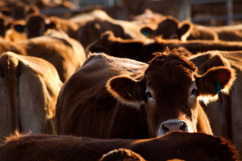Cattle prices are coming under pressure from slow consumer demand and ample supply, Eblex has warned.
This combination, experienced by both domestic and imported beef, continues to drive some restraint among processors, the red meat levy board reported, resulting in “downward pressures” on the prime cattle market.

In the week ending 18 April prices for all classes of cattle fell – all prime deadweight cattle prices were 3p down on the previous week.
Similar pressures have been felt in the Scottish beef cattle trade, where animals have been kept on farms instead of being sent for slaughter. Eblex said this was giving rise to fears the beef market could return to the crisis point it found itself in last year when the beef price crashed.
However, Debbie Butcher, senior market analyst at Eblex, said this could change as the season moves into its “transitional period”.
“This development has been a feature of the market for a couple of months or so and reflects the continued imbalance in supply and demand. However, with the expectations that cattle supplies are set to tighten, (throughputs in March and April so far suggest this may have already started) the balance in the trade could move into a position that is less out of kilter, in particular as the season moves towards its transitional period between yarded and grass-fed supplies,” Butcher commented.
Eblex reported that lower cattle numbers in Ireland, resulting in fewer imports, could help support the market in the medium term.
“However, with the current fine weather unlikely to stimulate demand for roasting cuts, it is likely that caution among processors could persist in the short term, which, coupled with the euro exchange rate and its impact on the competitiveness of UK product on the continent, continues to offer some downside risk to the trade,” Butcher concluded.